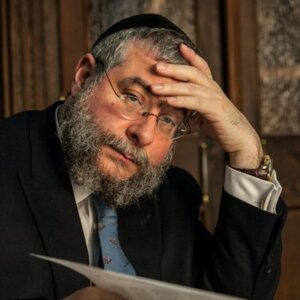Adin Steinsaltz was essential to the revival of the Russian Jewish community

Image by Getty Images
In the wake of his passing on August 7, 2020, I remember Rabbi Adin Steinsaltz in conversation, as the ever youthful rebel, questioning the whole universe, with a biting sense of humour.
In the Orthodox world, where clothing defines the person, he made sure to stand out as a unique creature, combining worn jeans with a Hasidic black overcoat. His “Einsteinian” hair flew all over, his face beset by penetrating devilish laughing eyes looking down to the perpetual smoking pipe. Academics saw him as a rabbi and rabbis considered him as an Academic. And he was the quintessential postmodern religious Israeli, a Zionist with Chabad leanings, a rabbi with academic roots.
In 1988, Rabbi Adin Steinsaltz was nominated to receive the Israel Prize for his monumental work, a modern commentary to the Talmud. But Steinsaltz didn’t appear at the ceremony in the President’s residence. Rumor was that Steinsaltz had qualms appearing at a ceremony celebrating the State of Israel.
However, the real reason was totally different. Steinsaltz had a secret meeting with the Vice President of the Academy of Sciences of the USSR in order to discuss the founding of a spiritual center for Soviet Jews in Moscow under the auspices of the Academy. The agreement hammered out during this meeting established a center of Jewish learning, inviting foreigners to be teachers. This was the first time such an institution was allowed since the Bolshevik revolution 70 years earlier.
With the establishment of the Steinsaltz Center in Moscow in 1988, the underground Jewish Hebrew teachers – Refusenik movements, which had existed since the 1970s — came out of hiding to participate in the activities and curriculum of the institute. The underground movements differed in their religious and political affiliation — the Essas group was associated with Lithuanian Orthodoxy and the Dashevsky group with Religious Zionism — but all took part in the Steinsaltz Center’s activities.
However, Steinsaltz was a controversial figure. Some leaders of the Orthodox underground sought to force the ultra-Orthodox groups to distance themselves from the Steinsaltz Yeshiva in order to retain the ideological purity of their movement. Rafael Entin, a former Refusenik turned Talmudic scholar living in Bnei Brak, read the published works of R. Steinsaltz, including his seminal commentary on the Talmud. He was so horrified by them that he approached Rabbi Menachem Man Schach, the leader of the Lithuanian Yeshiva World, to demand a ban on the Steinsaltz Center in Moscow, despite its centrality to Jewish life in Moscow.
R. Schach issued a ban on Steinsaltz’s Talmud, declaring it contrary to tradition. The ban caused thousands of traditional Orthodox schools and individuals to remove the Steinsaltz Talmud from their bookshelves. The Religious Zionists movement, which did not accept the authority of R Shach, published ads in the press asking for the Steinsaltz Talmud to be donated to their institutions instead of destroyed.
R. Schach’s ban put the Orthodox-affiliated Refusenik groups in the USSR in a difficult position. On one hand, their religious leader had basically excommunicated Steinsaltz. On the other hand, the Steinsaltz Center was the only organization with a base in the USSR openly teaching Judaism. It was effectively the center of all Jewish life in the USSR, including Orthodoxy.

Image by Getty Image
At the same time, around the end of 1988, my position as Head of the Rabbinical Court of the Soviet Union was approved by the Chief Rabbinate of Israel, and the World Jewish Congress sent me to the USSR to rebuild the Jewish community there. I left to Moscow on a pilot trip and was interviewed and accepted by the different Refusenik groups. However, there was one small problem: the only institution that could issue me an invitation was the Academy of Sciences, which included the Steinsalz Center banned by the leader of the Orthodox movement.
Since Rabbi Shach had issued a ban against Steinsaltz, this venue became extremely problematic. Rabbi Moshe Soloveichik went to see him, and convinced him to exclude the Steinsaltz Institution from the ban, allowing me to operate through the Steinsaltz Center.
The Center flourished in the years 1989-1990, becoming the pulsing center for Moscow’s Jews, disseminating Hebrew lessons, Judaism, information on Aliyah and the services of the Rabbinical Court established under its auspices. It quickly became the center of Jewish life in the Soviet capital.
Steinsaltz’s intent was to create a diverse faculty from all walks of traditional Judaism, giving Soviet Jews, who were often cut off from the Jewish people, the opportunity to meet a plethora of Jewish intellectuals from a range of affiliations. Thousands of people visited the Center and whoever visited from abroad always stopped by the Center, which became influential in Moscow’s Jewish life.
Its staff and students became important figureheads in Judaism and Zionism, including the Israeli district court justice, Zvi Tal, later nominated to the Supreme Court; Dr. David Berger, a historian from Brooklyn College who would later become famous through his crusade against Lubavitch messianism; Dr Shaul Stampfer, a historian of Hebrew U; and Rabbi Bulka, a retired American congregational rabbi.
Throughout it all, Rabbi Steinsaltz continued to be involved with Russian Jewry, visiting Russia often and speaking at conferences, remaining one of the most respected spiritual authorities for Russian-speaking Jewry. His Center was integral to the revival of the Russian Jewish community. His ability to connect and understand immediately his conversation partner was legendary. Whether one on one or speaking to an audience, he connected immediately, startling his audience with an unexpected thought. A brilliant mind in search of making our world a better place, he was as comfortable with secular audiences as he was with Kabbalists and Hasidic masters. A truly unique, great mind, which was a blessing to the world.
Rabbi Pinchas Goldschmidt has been the Chief Rabbi of Moscow, Russia since 1993.

















